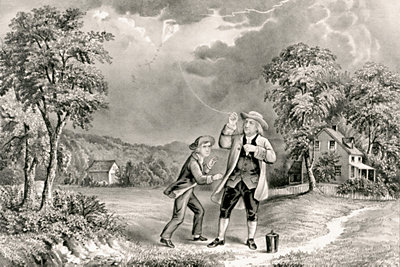When Did Homes First Get Electricity? A Historical Insight
Did you know that electricity's earliest roots date back to around 600 B.C.? It all started with a curious Greek philosopher named Thales, who stumbled upon static electricity while experimenting with amber and silk.
Fast forward to today, and electricity has become an integral part of our daily lives, powering everything from our homes to our smartphones. But how did electricity make its way into our homes, reshaping the way we live?
If you're curious about the journey of electricity into the modern home, you're in the right place. Join us as we explore the evolution of electric light and power within households. From its humble beginnings to the transformative milestones that led to widespread electrification, we'll uncover the fascinating story behind the electrification of homes. Plus, we'll take a glimpse into what the future may hold for this essential energy source. So, let's dive in and discover the electrifying history of our homes!
Early Days of Electricity
In school, we're typically introduced to the concept of electricity in a simplified manner. We've all heard the famous tale of Benjamin Franklin flying a kite with a key attached, getting struck by lightning, and voilà, electricity! But there's got to be more to the story than that!
Notable Names in Electricity
Before Franklin's famous experiment, Europe was already abuzz with early explorations into the mysteries of electricity, long predating the United States' involvement. Interestingly, the word "electricity" itself finds its roots in the works of English scientist William Gilbert during the 15th century, who introduced the term "electricus." It was later modified by Sir Thomas Browne to become the familiar term we use today.
Throughout Europe, pioneering scientists such as Otto von Guericke, Stephen Gray, Ewald Georg von Kleist, and Pieter van Musschenbroek made significant contributions to the burgeoning field of electricity. Among their many achievements, one stands out—the invention of the Leyden Jar, an early form of battery, which remains one of the most famous studies in the history of electricity.
Electricity in America
In 1752, Benjamin Franklin etched his name in history with a daring experiment that remains both captivating and perilous to this day. Crafting a kite equipped with a wire, Franklin used a silk and hemp rope to conduct an electrical charge. Together with his son, he launched the kite into the stormy skies during a thunderstorm, aiming to uncover the secrets of electricity.
Two crucial points merit attention. Contrary to popular belief, Franklin's kite was not directly struck by lightning—a stroke that surely would have spelled disaster. Instead, his experiment harnessed the power of a Leyden jar to "collect electric fire," as recounted by the scientist Joseph Priestly. This collaborative effort is a perfect example of the communal nature of electricity's discovery and utilization.
Meanwhile, across the pond in Europe, Franklin's contemporaries and successors continued to push the boundaries of electrical innovation. Italian scientist Alessandro Volta, the namesake of the "volt" and "voltage," revolutionized the field with the invention of the first true battery. Not to be outdone, England's Michael Faraday made pivotal contributions by demonstrating electric fields, laying the groundwork for future advancements in generators and transformers.
Beyond Discovery
As these innovations continued to shape and revolutionize various industries, two towering figures emerged in America's electrical landscape. One name that resonates with many Americans is Thomas Edison.
Renowned as the mastermind behind the invention of the light bulb, Edison's contributions extend far beyond mere illumination. He also pioneered the establishment of the world's first electric power distribution system, a monumental achievement that marked the beginning of widespread electrification in homes and communities across the globe.
Standing alongside Edison, albeit often depicted as a rival in popular culture, is the Serbian-American inventor Nikola Tesla. Tesla's groundbreaking work in alternating current (AC) electricity fundamentally transformed the way we harness and utilize electrical power, leaving an indelible mark on the field.
While Tesla and Edison are often portrayed as adversaries in popular narratives, scholars and historians argue that evidence of true animosity between them is lacking. In reality, their relationship was more nuanced, marked by a mix of collaboration and competition as they each pursued their respective visions for the future of electricity.
When Did Homes Get Electricity?
Now that we have a glimpse into electricity's origins, let's explore its journey into the heart of the home. When did homes first embrace electricity, and how did it become such an integral part of domestic life?
In the early 19th century, homes were still illuminated by traditional means. Candles crafted from tallow and wax, along with dim oil lamps and gas lighting, cast a warm yet subdued glow. Modern conveniences like electric heating and cooling were but distant dreams.
In the United States, the dawn of electrification began to illuminate homes in the late 19th century. A pivotal moment occurred in 1878 when Thomas Edison, the prolific inventor himself, installed the first private electric system in his own residence.
This milestone event sparked a wave of electrification that rippled across borders. In Canada, the first private electric system flickered to life in 1882, marking the beginning of a transformative era. Across the pond, the United Kingdom had already begun experimenting with public lighting in the early 1800s, culminating in the launch of its first private system in 1881.
Similarly, Australia embraced electricity shortly after Edison's groundbreaking invention in 1880, heralding a new era of illumination and innovation. Meanwhile, on March 25th, 1878, the Institute of Technology in Tokyo illuminated the path forward by utilizing electricity to power an arc lamp. Eight years later, Tokyo Electric Lighting emerged as Japan's inaugural power company, symbolizing the nation's electrifying leap into the future.
The Spread of Electricity in Homes
One noteworthy observation is the remarkable pace at which the adoption of electricity unfolded across the globe. In hindsight, it's striking to see how swiftly societies embraced this transformative technology, without hesitation or fear.
Within a mere decade of Edison illuminating his workshop with electric light, the glow of electricity had already traversed vast distances, reaching as far as Japan. This rapid diffusion underscores the universal appeal and readiness of communities worldwide to embrace the electrifying possibilities that lay ahead.
A Few Road Bumps
It's essential to recognize that the journey to harnessing electricity wasn't a swift or straightforward one. The burgeoning industry encountered numerous obstacles along the way, each demanding innovative solutions and determined perseverance.
One of the earliest challenges involved the generation of power itself. According to the National Museum of American History, a significant milestone was achieved at Niagara Falls with the establishment of the first large-scale power-generating operation. Utilizing a two-phase AC technique pioneered by Nikola Tesla, this facility supplied electricity to nearby Buffalo, marking a groundbreaking achievement in long-distance energy transmission.
In Buffalo, this newfound source of energy found practical applications in lighting and powering streetcars, providing tangible evidence of the viability of transmitting electricity over extended distances as the 20th century dawned.
Meanwhile, closer to the majestic Falls, the locally generated power played a pivotal role in the production of aluminum—an industry that was itself in its nascent stages. This dual demonstration not only showcased the utility of electricity in diverse industrial applications but also laid the groundwork for further advancements in electrical engineering and industrial innovation.
Bringing Down Costs
Addressing the affordability of electricity transmission posed yet another significant challenge. While feasible, the cost of transmission was often exorbitant, rendering electricity inaccessible to many rural areas, particularly farms, well into the 20th century.
The disparity in electrification between urban and rural regions was glaring, with some farms in America still operating without electricity as late as the 1930s—a stark contrast to the rapid global spread of electricity during the same period.
To address this pressing issue, President Franklin Roosevelt took decisive action by signing the Rural Electrification Act (REA) into law in 1936. This landmark legislation aimed to tackle the staggering statistic that approximately 90% of farms across the nation lacked access to electricity.
The REA functioned by providing federal government loans to eligible applicants, facilitating the expansion of electricity infrastructure to previously underserved rural communities. Spanning nearly six decades until its conclusion in 1993, the REA stands as one of the most impactful initiatives in American history, significantly transforming rural life and modernizing agricultural practices.
The legacy of the REA didn't end with its official closure. In 2008, President Bush amended the REA to extend its scope, facilitating the deployment of telecommunications and internet services to rural areas. Subsequently, in 2012, President Obama further expanded the REA to support the nationwide rollout of high-speed broadband—a testament to the enduring relevance and adaptability of this landmark legislation.
Electricity in Modern Homes
Reflecting on the monumental journey to electrify the nation, where do we stand today? To find a home devoid of electricity, one would need to venture far beyond the reaches of the national grid—an almost unthinkable notion in the modern era.
While electricity's initial purpose was to illuminate spaces, visionaries of the time foresaw its potential to power far more than just light bulbs and sewing machines.
Fast forward to the present day, and electricity plays an indispensable role in our daily lives, powering an array of tools, conveniences, and appliances that range from the humble vacuum cleaner to sophisticated cooking equipment, washing machines, water heaters, and beyond.
Across the nation, electricity has not only enhanced comfort but also improved safety, particularly in regions grappling with extreme weather conditions. In states like Florida and Nevada, where scorching heat is a constant challenge, electric air cooling systems have become essential in preventing heat-related illnesses. Conversely, during harsh winter months, electricity has proven lifesaving by providing warmth and protection against the bitter cold.
In 1938, President Franklin Roosevelt aptly remarked that "electricity is a modern necessity of life." Nearly a century later, his words ring truer than ever. Electricity has woven itself into the very fabric of our existence, evolving from a mere necessity to a ubiquitous luxury so ingrained in our daily routines that its significance often goes unnoticed.
The Future of Home Electricity
Considering the future of electricity is akin to peering into a crystal ball—we can't predict with certainty, but there are certainly trends worth monitoring.
One significant shift on the horizon revolves around the transition to cleaner power sources. The conventional methods of electricity generation, predominantly reliant on fossil fuels, contribute significantly to pollution. Consequently, there's a growing consensus among Americans in favor of transitioning away from oil and coal and toward renewable energy sources such as solar, wind, and hydroelectric power.
Moreover, the allure of electric power extends beyond stationary applications into the realm of transportation. The rise of electric vehicles (EVs) has been gaining traction, reshaping not only the automotive industry but also influencing our homes with the emergence of EV charging stations. As more individuals seek to embrace sustainable transportation options, we can anticipate the proliferation of EV infrastructure to continue expanding, facilitating broader adoption of electric vehicles across the nation.
Mastering Lightning in Your Home
From its early days of risky high voltages to its now indispensable role in modern living, electricity has been at the core of our home evolution. From gas lamps to intricate networks of wires, it has shaped our domestic landscape.
If you need help managing the electricity that powers your home, Parker & Sons is here for you. With over 50 years of experience, our skilled electricians can assist you with appointments, inspections, or consultations tailored to your needs. Contact us today to ensure your home's electrical system is safe and efficient.
Related Reading
Subscribe to our e-Newsletter
Stay up-to-date on current news, promotions, and industry tips.

